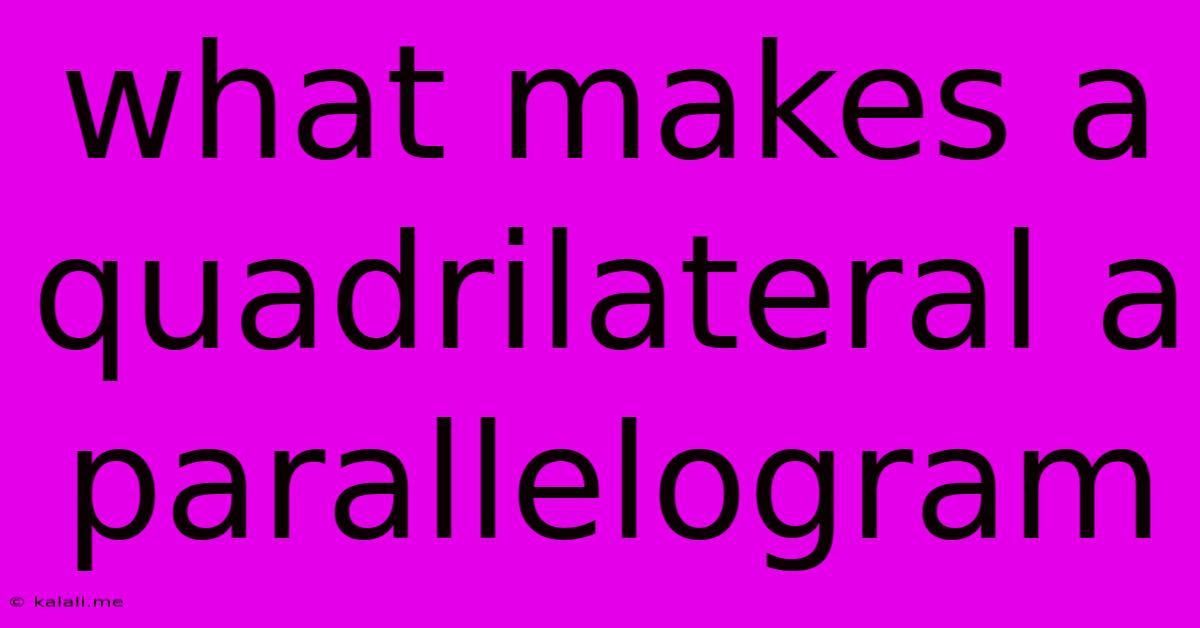What Makes A Quadrilateral A Parallelogram
Kalali
May 10, 2025 · 3 min read

Table of Contents
What Makes a Quadrilateral a Parallelogram? A Deep Dive into Properties and Proofs
Understanding the properties that define a parallelogram is fundamental to geometry. This article will explore the essential characteristics that distinguish parallelograms from other quadrilaterals, offering clear explanations and visual aids to solidify your understanding. We’ll delve into different ways to prove a quadrilateral is a parallelogram, equipping you with the knowledge to tackle various geometric problems.
A parallelogram is a quadrilateral with opposite sides parallel. This seemingly simple definition unlocks a wealth of other properties. Let's examine these in detail.
Key Properties of Parallelograms
-
Opposite sides are parallel: This is the defining characteristic. Think of it like two sets of parallel lines forming a closed shape.
-
Opposite sides are congruent: This means the lengths of opposite sides are equal. If you measure the lengths, you'll find they match.
-
Opposite angles are congruent: The angles directly opposite each other within the parallelogram are equal in measure.
-
Consecutive angles are supplementary: Any two angles that share a side (consecutive angles) add up to 180 degrees.
-
Diagonals bisect each other: The diagonals of a parallelogram intersect at a point that divides each diagonal into two equal segments.
Proving a Quadrilateral is a Parallelogram
There are several ways to demonstrate that a given quadrilateral is indeed a parallelogram. Knowing these methods is crucial for solving geometric problems. Here are some key approaches:
-
Showing Opposite Sides are Parallel: This is the most straightforward approach, directly referencing the definition. You can use slope calculations (in coordinate geometry) or angle relationships (using parallel lines cut by a transversal) to prove parallelism.
-
Showing Opposite Sides are Congruent: If you can demonstrate that opposite sides are equal in length, you've proven it's a parallelogram. This method relies on measuring or calculating side lengths.
-
Showing Opposite Angles are Congruent: Similar to the previous method, if you prove opposite angles are equal in measure, the quadrilateral is a parallelogram.
-
Showing Diagonals Bisect Each Other: If you can show that the diagonals cut each other exactly in half, the quadrilateral is a parallelogram. This is often used in coordinate geometry problems.
-
Showing One Pair of Opposite Sides is Both Parallel and Congruent: This combines elements of the first and second methods. If you can show that one pair of opposite sides is parallel and congruent, the quadrilateral is automatically a parallelogram. This is a powerful shortcut.
Examples and Applications
Imagine a scenario where you are given the coordinates of four points. To determine if they form a parallelogram, you would calculate the slopes of the segments connecting the points. If opposite sides have equal slopes (indicating parallelism), and opposite sides have equal lengths, you've successfully proven it's a parallelogram.
Similarly, in a problem involving angles, showing that opposite angles are congruent or consecutive angles are supplementary will confirm the parallelogram.
Understanding parallelogram properties is not only vital for geometric proofs but also has practical applications in areas like engineering (analyzing structures), physics (understanding forces), and computer graphics (creating shapes and transformations).
In conclusion, identifying a parallelogram hinges on understanding its defining characteristics and the various ways to prove its existence. By mastering these concepts, you'll significantly enhance your problem-solving skills in geometry and related fields. Remember to always refer back to the fundamental properties—parallel and congruent opposite sides—as your foundational understanding.
Latest Posts
Latest Posts
-
How Long Does It Take To Drive 2000 Miles
Jul 18, 2025
-
How Many Grams In A Teaspoon Of Cinnamon
Jul 18, 2025
-
How Long To Heat Water In Microwave
Jul 18, 2025
-
40 Oz Of Water Is How Many Cups
Jul 18, 2025
-
How Many Eighths In A Quarter Pound
Jul 18, 2025
Related Post
Thank you for visiting our website which covers about What Makes A Quadrilateral A Parallelogram . We hope the information provided has been useful to you. Feel free to contact us if you have any questions or need further assistance. See you next time and don't miss to bookmark.